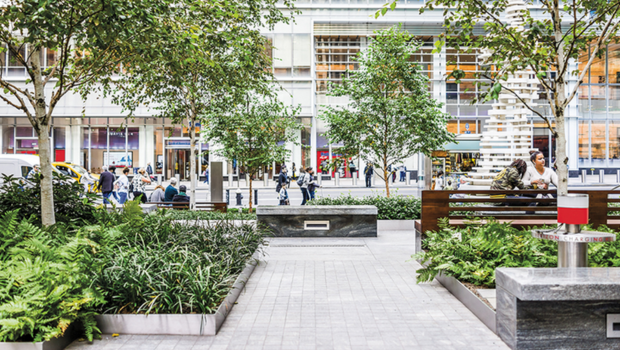The Winds of Change: Young Activists Pursue Climate Justice and Green Living
Born in the mid-to-late 1990s up to the early 2010s, Generation Z environmental activists agree that urgent action is needed to achieve climate justice, and they’re willing to do what it takes to get results. “Climate and environmental justice and environmental racism are very big concerns among youth, whether or not they are youth of color. It’s not just about energy, water or air—it’s also very much about people,” says Ana Garcia-Doyle, executive director of One Earth Collective. The Chicago nonprofit inspires action, facilitates learning and promotes environmental justice through annual programs like the One Earth Film Festival and One Earth Youth Voices, a summit designed to give voice to the next generation’s environmental concerns.
Teens Take Charge
Marin Chalmers, a sophomore at Oak Park River Forest High School, in Illinois, and member of One Earth’s Youth Advisory Council, has been participating in the One Earth Young Filmmakers contest since the seventh grade. Her short documentary, Sondaica, is about wildlife and ecosystems.
Chalmers credits One Earth with helping her connect with people that normally would not be involved with climate activism. Her peers share in the understanding that there’s a climate crisis. “The Earth is breaking,” she explains. “We need to fix it. Everybody needs to do a better job of taking action.” Getting people to pay attention is challenging, Chalmers laments, especially given America’s overwhelming dependence on automobiles and the lack of public transportation. “A lot of people want to help, but just don’t know how,” she notes. “Some people don’t have the financial ability to make environmentally sound choices.”
Although individual action can help mitigate climate change, 16-year-old Sebastian Delgado, a Revolutionary Youth Action League (ROYAL) volunteer, blames polluting, profit-driven corporations for the climate crisis. “The biggest threat to our climate and people of color is capitalism,” he explains. “We need a new economic system that’s not based on profit.”
ROYAL volunteers like Delgado collaborated with Marlene Brito-Millán, Ph.D., an ecology assistant professor at Loyola University, and Dr. Bryan Ramson, a nuclear physicist and research associate at Fermilab, to craft a social justice plan that incorporates climate town hall meetings to raise awareness and develop action plans. According to Delgado, even when concerned citizens contact their elected representatives, leaders can be slow to act. “Climate change has been happening for decades, and we’re still dealing with the same issues,” he remarks, adding that bold ideas and unwavering action are needed when government officials won’t listen to their constituents.
Greening Urban Areas
In Austin, a predominantly Black neighborhood on the west side of Chicago, two 20-year-olds, Cortez Dean and Ethan Horne, work at paid internships in an urban farming program called Austin Grown, which raises chickens and maintains gardens with vegetables and native pollinators.
A collaboration between One Earth Collective and BUILD Chicago, a nationally respected youth development organization, Austin Grown serves urban communities where fruits and vegetables are hard to find. The organization also offers gardening and healthy eating classes to the public.
Dean is learning firsthand how climate change adversely affects farms, gardens and forests where food and medicinal plants are grown. During a summer heat wave, he witnessed a sewer pipe explode, filling his neighborhood with a powerful stench, and he worries that aging infrastructure will contaminate their drinking water.
“People assume there’s time to solve climate change, but we’re not slowing things down. There’s a lot of work to be done,” Horne says, noting that food deserts disproportionately affect communities of color. “There are lots of areas with no grocery stores, or stores that only offer chips and candy, but no fruits and vegetables.”
Dean and Horne concur that gardening provides needed green infrastructure and nutritional food to underserved populations. “I didn’t fully understand climate change until I put my hands into the soil. When you do that, you’ll see Earth for what it is—and the damage we’ve done to it,” Dean says.
Activism on University Campuses
Originally from Waukesha County, Wisconsin, 21-year-old Grace Arnold feels lucky to have attended two schools with strong environmental programs and student engagement. At the University of Vermont, she participated in marches against fossil fuels and joined lively discussions about climate-related racism at the Social Justice Coalition. Now a student at University of Texas at Austin, she is enrolled in environmental studies classes and notes, “Students are forming environmental clubs. I’m grateful to again be surrounded by people trying to get their voices heard.”
Arnold was a social media volunteer for Plastic-Free MKE, a Milwaukee-based organization dedicated to reducing single-use plastic waste. She credits social media as a powerful tool that helps her generation reach people and organize activism. “Climate change is intertwined with social, economic and political issues,” she relates. “But small actions can make big impacts—and voting is a powerful thing.”
Sheila Julson is a freelance writer and contributor to Natural Awakenings magazine.




























